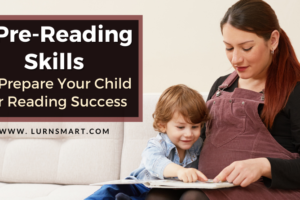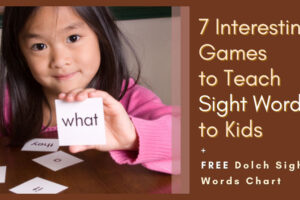Fun Phonemic Awareness Activities to Develop Sound Awareness Skills
- Categories Early Learning, Reading
- Tags Reading time 7 min
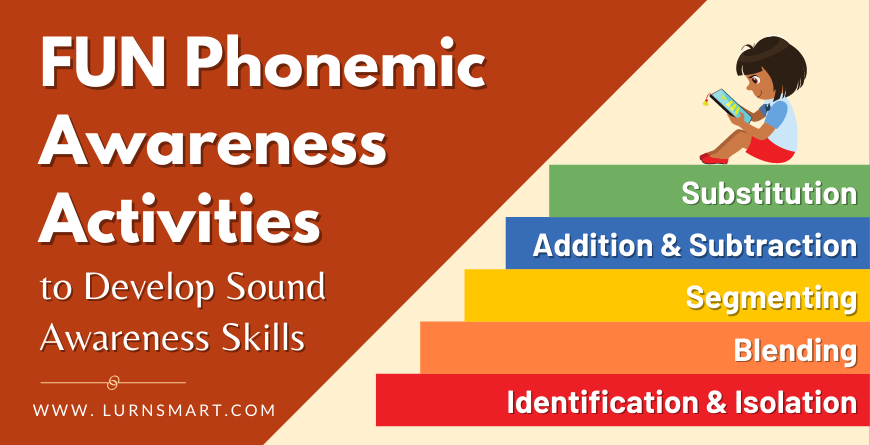
Phonemic awareness activities help develop sounds awareness in kids!
In this post, I’m going to share with you simple yet creative ways to build the 5 most important phonemic awareness skills through daily conversations and fun activities!
But before we get to the different phonemic awareness activities that you can do, if you are someone who is new to the term ‘phonemic awareness,’ then you might want to learn about this important phonics buzzword.
So click on the link that is more relevant to you to get to a particular section of the blog post. If not, just click here to learn about the 5 important phonemic awareness skills and the different activities that you can do to build them.
- What is Phonemic Awareness?
- Benefits of Early Phonemic Awareness
- Phonemic Awareness Activities to Develop the 5 Important PA Skills
- Difference between Phonological Awareness and Phonemic Awareness
- Examples of Phonological Awareness and Phonemic Awareness
What is Phonemic Awareness?
Most people know that English has 26 letters A-Z but not many are aware of the fact that the 26 letters are nothing but symbols that represent the 44 Sounds in English.
And Phonemic awareness is the ability to hear, identify, and work with those 44 sounds in the spoken language.
Since it is just an auditory skill, it is not required that children need to learn their ABCs yet!
Instead, all they need to learn is how to use their little ears to pay attention to the sounds in the spoken language.
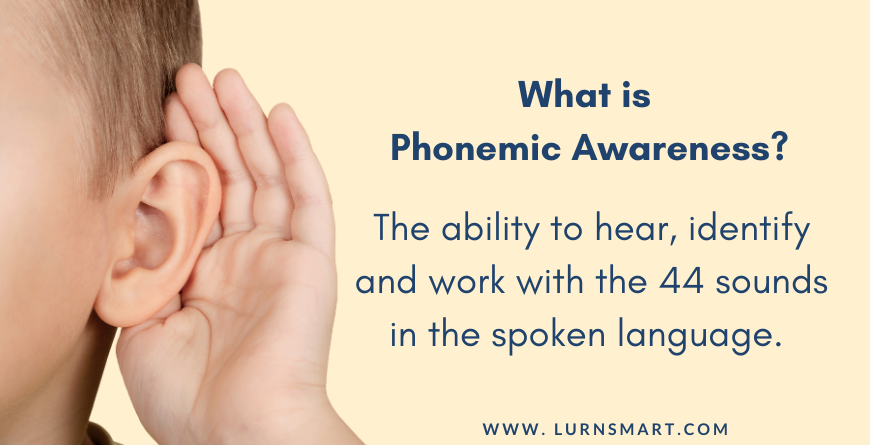
Benefits of Early Phonemic Awareness:
Have you ever been in awe at a toddler or preschooler who could read fluently and accurately?
Well, the secret behind what makes it possible for those little children who are still in their diapers to read is that they have developed early phonemic awareness.
According to Dr. Marilyn Adams, a cognition and education specialist, phonemic awareness is one of the most important predictors of early reading success.
Here are some examples to help you understand better!
“Ahhhhh…. I hear the /m/ sound in the word MAT.”
“I think I also hear the ‘t’ sound at the end of the word MAT.”
“Hey, wait! The words MAT and MAN begin with the same sound /m/.”
If a child can play around with sounds like this in the spoken language, when you introduce ABCs, the child will find it easy and simple to understand the relationship between the sounds and the letters that they represent in print.
And this understanding is nothing but the ‘ability to read.’
So it doesn’t matter if your child is a 2-year-old or 4-year-old, you can help your child develop this skill easily by just talking, reading, and playing in a certain way.
Phonemic Awareness Activities to Develop the 5 Important Skills:
There are 5 different phonemic awareness skills that build fluency and efficiency in reading!
The good news is, you do not need any extra time to help your child develop these skills.
All you need to do is, include them in your daily conversations and daily reading time and you can easily increase your child’s awareness and understanding of these important skills.
Now let’s explore the 5 important skills along with engaging phonemic awareness activities that you can do with your child:
1. IDENTIFICATION & ISOLATION:
As the name suggests, identification and isolation are the abilities to identify and isolate a sound in a word.
Example:

How can you teach identification and isolation?
Here are 3 simple phonemic awareness activities that you can do to increase your child’s sound awareness as well as help your child identify and isolate sounds in words:
1. OBJECT SOUND IDENTIFICATION:
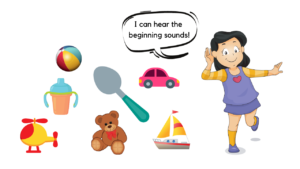
To play this game, pick a handful of random objects from around the house and help your child identify them by their beginning sound.
When you do this, remember to stress on the beginning sound and the ending sound!
Here’s an example!
2. OBJECT SOUND SORTING:

Once your child is able to identify objects using their beginning sounds, you can have your child sort the objects by their beginning sounds.
Here’s an example!
Spoon, sippy cup, and sailboat go together!
3. FIND THE PAIR/ODD ONE OUT:
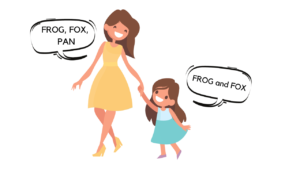 Now that your child is used to hearing and identify sounds in words, pick 2 words that begin with the same sound along with a word that begins with a different sound. Now have your child identify the words that begin with the same sound or identify the word that does not begin with the same sound.
Now that your child is used to hearing and identify sounds in words, pick 2 words that begin with the same sound along with a word that begins with a different sound. Now have your child identify the words that begin with the same sound or identify the word that does not begin with the same sound.
Here’s an example!
Apart from these games, pick a couple of words a day while talking or while reading to apply these skills in real-time as they will:
- Increase your child’s awareness of sounds in a playful way.
- Help your child notice how words can be similar and different in a more natural way.
By the way, if you want to do some fun Phonemic Awareness activities with your child then check out our FREE Beginning Sound Sorting and Matching Cards and our FREE Phoneme Identification and Isolation from our freebie’s page!
2. BLENDING:
Blending is the ability to mentally string sounds together to form words.
Example:
As simple as this might sound, this is one of the most important skills that will empower your child to read fluently and easily once he or she starts reading.
Because if your child can string sounds orally, doing the same in print is simple and easy!

How can you teach blending?
The skills blending and segmenting often go together. We will discuss ways to build these two phonemic awareness skills together in the next section.
3. SEGMENTING:
Segmenting is just the opposite of blending, it is breaking a word down into its individual sounds.
Example:
This ability to break a word down into individual sounds will help your child spell words, including new and unfamiliar words, easily.

How can you teach blending and segmenting?
A simple thing that you can do to help your child practice blending and segment is to Sound Talk.
A cool thing about Sound Talk is that it can be done anytime, anywhere and you don’t need anything to do it!
1. SOUND TALK:
 To sound talk, pick a couple of simple words a day.
To sound talk, pick a couple of simple words a day.
A general rule of thumb would be to do 2-3 words a day!
Here’s an example!
If you want your child to hand over his or her toy to you. You can say, “Give me that /t/ /oy/ please!”
Now your child has to figure out what /t/ /oy/ means.
Its TOY!
Note: When you say /t/ /oy/ you break the word TOY into its individual sounds so it is ‘segmenting’ and when your child figures out that /t/ /oy/ is TOY, your child puts those sounds together to get the word TOY, so it is ‘blending.’
When you first introduce this game to your child, you might have to segment and blend a handful of words before your child gets the hang of it!
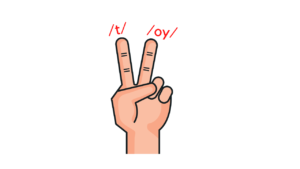 A simple tip when you Sound Talk, is to hold up your fingers and count the sounds as you break a word into its individual sounds so your child can visually see the number of sounds in the word!
A simple tip when you Sound Talk, is to hold up your fingers and count the sounds as you break a word into its individual sounds so your child can visually see the number of sounds in the word!
Trust me, the more often you Sound Talk and make it look silly, the easier it is for your child to understand that words can be broken down into sounds and sounds can be put together to form words–a very important knowledge to have when it comes to reading and spelling.
By the way, if you are new to the sounds in English, then check out my video on the 44 Phonics Sounds in English.
I also suggest you read my blog post, 6 Fun Blending Sounds Activities + Step-by-Step Guide to Teach Blending to learn how to teach the concept of blending to your child easily.
4. ADDITION AND SUBTRACTION:
As the name suggests, addition and subtraction are adding sounds and taking away sounds to form new words.
Example:
Interesting isn’t it?

How can you teach addition and subtraction?
Here is a simple phonemic awareness activity that you can play with your child to teach this skill:
1. I’M A LITTLE WORD MAGICIAN:
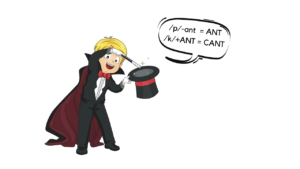 To do this activity, pick simple words that have a word within them like PANT, STAND, and TENT, or words to which you can add a sound or two and turn them into a new word.
To do this activity, pick simple words that have a word within them like PANT, STAND, and TENT, or words to which you can add a sound or two and turn them into a new word.
Here are some examples!
If you choose the word PANT, there is an ANT in the word PANT. Now slow down and stretch the word. Let your child hear the word and identify the word ANT within the word PANT. Now your child has to take away the /p/ sound to get the word ANT. This is subtraction.
For addition, you can ask, “What sound can we add at the beginning of the word ANT so we can get a new word? Can we add the sound /k/ to make it CANT or can we add the sound /m/ to make MANT?”
I know MANT is not a word, but at this point, getting the right word is not important, but getting the concept is.
So create nonsensical words intentionally as it will make the activity fun and interesting!
5. SUBSTITUTION:
As the name suggests, substitution is the ability to replace a sound with another to get a new word.
Example:
If you substitute the sound /b/ in the word BAT with /r/ you get RAT.
But if you substitute /r/ in the word RAT with /m/ you end up with MAT.

How can you teach substitution?
Here are 2 simple phonemic awareness activities that you can do to help your child substitute sounds in words.
1. SILLY RHYMES
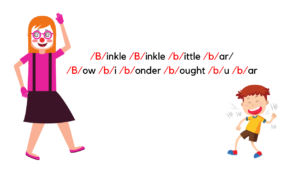 Pick a rhyme that is familiar to your child and replace the beginning sound in the words with another sound:
Pick a rhyme that is familiar to your child and replace the beginning sound in the words with another sound:
Here’s an example!
If you take the nursery rhyme Twinkle, Twinkle Little Star, replace the first sound in words with the sound /b/
/b/inkle /b/inkle /b/ittle /b/ ar/
/b/ ow /b/I /b/onder /b/ ought //bou/ /bar
Kids find this really funny and I’m sure your child will as well!
2. NONSENSICAL WORDS:
 Apart from Silly Rhymes, pick a couple of words while reading to substitute sounds. Make it look like a game.
Apart from Silly Rhymes, pick a couple of words while reading to substitute sounds. Make it look like a game.
I suggest you create nonsensical words intentionally so your child finds it interesting!
Here’s an example!
In the sentence, “The cat sat on the mat,” replace the /k/ sound in cat with /h/.
So it would be, “The hat sat on the mat.
Invite your child to try with you. If it is silly, most children will readily participate.
Difference between Phonological Awareness and Phonemic Awareness:
Now that we have learned all about phonemic awareness, let us learn about the difference between phonemic awareness and phonological awareness.
Oftentimes, people get confused between the terms phonemic awareness and phonological awareness. And so, they use them interchangeably but these two terms are completely different.
Here’s how!
Phonological awareness is a larger skill. It involves working with both, sounds as well as sound units in the spoken language.
Whereas phonemic awareness is just a part of phonological awareness, and it involves working with only the sounds and not sound units in the spoken language.
An easy way to remember the difference is to imagine a house!
If the house is phonological awareness, phonemic awareness is just one of the many rooms in the house.

Examples of Phonemic Awareness and Phonological Awareness:
Here are a couple of examples to help you learn the difference between phonemic awareness and phonological awareness better!
When you say that the word ‘sat’ ends with the sound /t/, you are just working with only one sound /t/ – This is called ‘phoneme identification’, which is one of the 5 phonemic awareness skills. And phonemic awareness is one of the many phonological awareness skills.
If you say that the word ‘sat’ and the word ‘bat’ end with ‘at’, you are working with two sounds ‘a’ and ‘t’. This is a ‘sound unit’ because there is more than one sound that we are working on. This is ‘identifying the rime’ which is one of the many phonological awareness skills.
If you want to learn more about the other phonological awareness skills such as word awareness, syllables, onset and rime, and rhymes and alliterations including fun ways to teach them to your child, then check out my post, Easy Phonological Awareness Activities to Build Reading & Spelling Skills
If you are supporting your child to read at home, then you might want to read my blog post Teach Your Child to Read Using Phonics: The Ultimate 7-Step Guide for step-by-step instructions and all the necessary resources that you might need to help your child read and spell easily and efficiently.
I hope you found the information and resources shared in this post ‘Fun Phonemic Awareness Activities to Develop Sound Awareness Skills’ useful!
If so, let us know in the comments below.
Would love to hear from you!
Previous post
Easy Phonological Awareness Activities to Build Reading & Spelling Skills
You may also like


